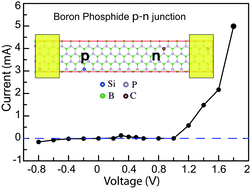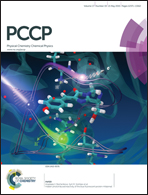Realization of a p–n junction in a single layer boron-phosphide
Abstract
Two-dimensional (2D) materials have attracted growing interest due to their potential use in the next generation of nanoelectronic and optoelectronic applications. On the basis of first-principles calculations based on density functional theory, we first investigate the electronic and mechanical properties of single layer boron phosphide (h-BP). Our calculations show that h-BP is a mechanically stable 2D material with a direct band gap of 0.9 eV at the K-point, promising for both electronic and optoelectronic applications. We next investigate the electron transport properties of a p–n junction constructed from single layer boron phosphide (h-BP) using the non-equilibrium Green's function formalism. The n- and p-type doping of BP are achieved by substitutional doping of B with C and P with Si, respectively. C(Si) substitutional doping creates donor (acceptor) states close to the conduction (valence) band edge of BP, which are essential to construct an efficient p–n junction. By modifying the structure and doping concentration, it is possible to tune the electronic and transport properties of the p–n junction which exhibits not only diode characteristics with a large current rectification but also negative differential resistance (NDR). The degree of NDR can be easily tuned via device engineering.


 Please wait while we load your content...
Please wait while we load your content...